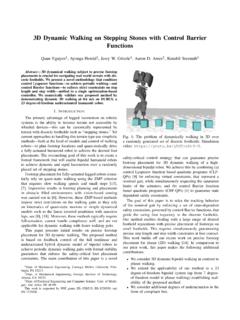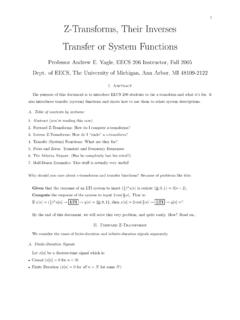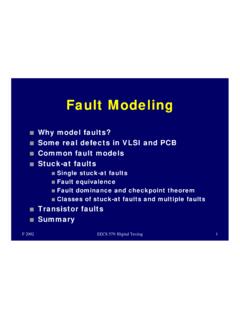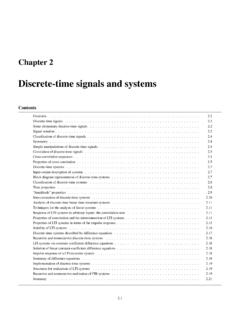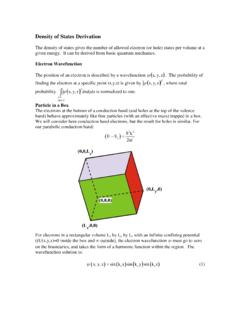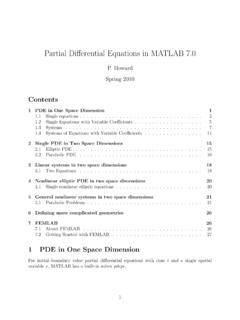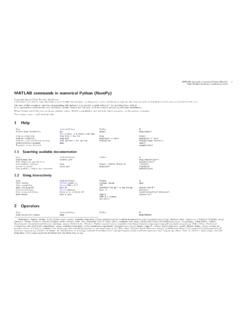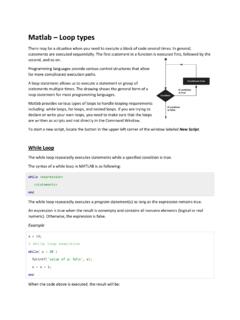Transcription of A Quick Tutorial on MATLAB - Electrical Engineering and ...
1 A Quick Tutorial on MATLABG owtham BellalaMATLAB MATLAB is a software package for doing numerical computation. It was originally designed for solving linear algebra type problems using matrices. It s name is derived from MATrix LABoratory. MATLAB has since been expanded and now has built-in functions for solving problems requiring data analysis, signal processing, optimization, and several other types of scientific computations. It also contains functions for 2-D and 3-D graphics and Variable names Variable names are case sensitive. Variable names can contain up to 63 characters ( as of MATLAB and newer). Variable names must start with a letter and can be followed by letters, digits and :>> x = 2;>> abc_123 = ;>> 1ab = 2;Error: Unexpected MATLAB expressionMATLAB Special Variables piValue of epsSmallest incremental number infInfinity NaNNot a number 0/0 i and ji = j = square root of -1 realminThe smallest usable positive real number realmaxThe largest usable positive real numberMATLAB Relational operators MATLAB supports six relational operators.
2 Less Than<Less Than or Equal<=Greater Than>Greater Than or Equal>=Equal To==Not Equal To~= (NOT != like in C) MATLAB Logical OperatorsMATLAB supports three logical ~% highest precedenceand&% equal precedence with oror|% equal precedence with andMatrices and MATLABMATLAB Matrices MATLAB treats all variables as matrices. For our purposes a matrix can be thought of as an array, in fact, that is how it isstored. Vectors are special forms of matrices and contain only one row OR one column. Scalars are matrices with only one row AND one columnGenerating Matrices A scalar can be created in MATLAB as follows:>> x = 23; A matrix with only one row is called a row vector. A row vector can be created in MATLAB as follows (note the commas):>> y = [12,10,-3]y = 12 10 -3 A matrix with only one column is called a column vector. A column vector can be created in MATLAB as follows:>> z = [12;10;-3]z =1210-3 Generating Matrices MATLAB treats row vector and column vector very differently A matrix can be created in MATLAB as follows (note the commas and semicolons)>> X = [1,2,3;4,5,6;7,8,9]X = 1 2 34 5 67 8 9 Matrices must be rectangular!
3 The Matrix in MATLABA(2,4)A(17)Note: Unlike C, MATLAB s indices start from 1 Extracting a Sub-matrix A portion of a matrix can be extracted and stored in a smaller matrix by specifying the names of both matrices and the rows and columns to extract. The syntax is:sub_matrix = matrix ( r1 : r2 , c1 : c2 ) ;where r1 and r2specify the beginning and ending rows and c1and c2specify the beginning and ending columns to be extracted to make the new a Sub-matrix Example :>> X = [1,2,3;4,5,6;7,8,9]X = 1 2 34 5 67 8 9>> X22 = X(1:2 , 2:3)X22 = 2 35 6>> X13 = X(3,1:3)X13 =7 8 9>> X21 = X(1:2,1)X21 =14 Matrix Extension >> a = [1,2i, ]a =1 0+2i >> a(2,4) = =1 0+2i 00 0 0 repmat replicates and tiles a matrix>> b = [1,2;3,4]b =1 23 4>> b_rep = repmat(b,1,2)b_rep =1 2 1 23 4 3 4 Concatenation>> a = [1,2;3,4]a =1 23 4>> a_cat =[a,2*a;3*a,2*a]a_cat =1 2 2 43 4 6 83 6 2 49 12 6 8 NOTE: The resulting matrix must be rectangularMatrix Addition Increment all the elements of a matrix by a single value>> x = [1,2.]
4 3,4]x = 1 23 4>> y = x + 5y =6 78 9 Adding two matrices>> xsy = x + yxsy =7 911 13>> z = [1, ]z =1 >> xsz = x + z??? Error using => plusMatrix dimensions must agreeMatrix Multiplication Matrix multiplication>> a = [1,2;3,4]; (2x2)>> b = [1,1]; (1x2)>> c = b*ac =4 6>> c = a*b??? Error using ==> mtimesInner matrix dimensions must agree. Element wise multiplication>> a = [1,2;3,4];>> b = [1, ;1/3, ];>> c = a.*bc =1 11 1 Matrix Element wise operations >> a = [1,2;1,3];>> b = [2,2;2,1]; Element wise division>> c = = 3 Element wise multiplication>> c = a.*bc = 2 42 3 Element wise power operation>> c = a.^2c = 1 41 9>> c = a.^bc =1 41 3 Matrix Manipulation functions zeros : creates an array of all zeros, Ex: x = zeros(3,2) ones : creates an array of all ones, Ex: x = ones(2) eye : creates an identity matrix, Ex: x = eye(3) rand : generates uniformly distributed random numbers in [0,1] diag: Diagonal matrices and diagonal of a matrix size : returns array dimensions length : returns length of a vector (row or column) det: Matrix determinant inv : matrix inverse eig: evaluates eigenvalues and eigenvectors rank : rank of a matrix find : searches for the given values in an inbuilt math functionsElementary Math functions abs- finds absolute value of all elements in the matrix sign- signum function sin,cos.
5 - Trignometric functions asin, - Inverse trignometric functions exp- Exponential log,log10 - natural logarithm, logarithm (base 10) ceil,floor- round towards +infinity, -infinity respectively round- round towards nearest integer real,imag- real and imaginary part of a complex matrix sort- sort elements in ascending orderElementary Math functions sum,prod- summation and product of elements max,min- maximum and minimum of arrays mean,median average and median of arrays std,var- Standard deviation and varianceand many Fundamentals2D Plotting Example 1: Plot sin(x) and cos(x) over [0,2 ], on the same plot with different coloursMethod 1:>> x = linspace(0,2*pi,1000);>> y = sin(x);>> z = cos(x);>> hold on;>> plot(x,y, b );>> plot(x,z, g );>> xlabel X values ;>> ylabel Y values ;>> title Sample Plot ;>> legend ( Y data , Z data );>> hold off;2D PlottingMethod 2:>> x = 0 :2*pi;>> y = sin(x);>> z = cos(x);>> figure>> plot (x,y,x,z);>> xlabel X values ;>> ylabel Y values ;>> title Sample Plot ;>> legend ( Y data , Z data );>> grid on;2D Plotting Example 2: Plot the following functionMethod 1:>> t1 = linspace(0,1,1000);>> t2 = linspace(1,6,1000);>> y1 = t1;>> y2 = ;>> t = [t1,t2];>> y = [y1,y2];>> figure>> plot(t,y);>> xlabel t values , ylabel y values ; 61 /110 tttty2D PlottingMethod 2:>> t = linspace(0,6,1000);>> y = zeros(1,1000);>> y(t()<=1) = t(t()<=1);>> y(t()>1) = (t()>1);>> figure>> plot(t,y);>> xlabel t values ;>> ylabel y values ;Subplots Syntax: subplot (rows, columns, index)>> subplot(4,1,1)>>.
6 >> subplot(4,1,2)>> ..>> subplot(4,1,3)>> ..>> subplot(4,1,4)>> ..Importing/Exporting DataLoad and Save Using load and saveload filename - loads all variables from the file filename load filename x - loads only the variable x from the fileload filename a* - loads all variables starting with a for more information, type help loadat command promptsave filename - saves all workspace variables to a binary .mat file named filename x,y - saves variables x and y in more information, type help saveat command promptImport/Export from Excel sheet Copy data from an excel sheet >> x = xlsread(filename);% if the file contains numeric values, text and raw data values, then>> [numeric,txt,raw] = xlsread(filename); Copy data to an excel sheet>>x = xlswrite('c:\ MATLAB \work\ ',A,'A2:C4')% will write A to the workbook file, , and attempt to fit the elements of A into the rectangular worksheet region, A2:C4. On success, x will contain 1 , while on failure, x will contain 0.
7 For more information, type help xlswriteat command promptRead/write from a text file Writing onto a text file>> fid = fopen( , w );>> count = fwrite(fid,x);>> fclose(fid);% creates a file named in your workspace and stores the values of variable x in the file. count returns the number of values successfully stored. Do not forget to close the file at the end. Read from a text file>> fid = fopen( , r );>> X = fscanf(fid, %5d );>> fclose(fid);% opens the file which is in your workspace and loads the values in the format %5d into the variable useful commands: fread, fprintfFlow Control in MATLABFlow control MATLAB has five flow control statements- if statements- switchstatements- forloops- whileloops- breakstatements if statement The general form of the if statement is>> if expression>> ..>> elseif expression>> ..>> else >> ..>> end Example 1:>> if i == j>> a(i,j) = 2;>> elseif i >= j>> a(i,j) = 1;>> else>> a(i,j) = 0;>> end Example 2:>> if (attn> )&(grade>60)>> pass = 1;>> end switch statement switchSwitch among several cases based on expression The general form of the switchstatement is:>> switch switch_expr>> case case_expr1>>.
8 >> case case_expr2>> ..>> otherwise>> ..>> end Example :>> x = 2, y = 3;>> switch x>> case x==y>> disp('x and y are equal');>> case x>y>> disp('x is greater than y');>> otherwise>> disp('x is less than y');>> endx is less than yNote: Unlike C, MATLAB doesn t need BREAKs in each case for loop forRepeat statements a specific number of times The general form of a forstatement is>> for variable=expression>> ..>> ..>> end Example 1:>> for x = 0 :1>> printf( %d\n ,x);>> end Example 2:>> a = zeros(n,m);>> for i = 1:n>> for j = 1:m>> a(i,j) = 1/(i+j);>> end>> end while loop whileRepeat statements an indefinite number of times The general form of a whilestatement is>> while expression>> ..>> ..>> end Example 1:>> n = 1;>> y = zeros(1,10);>> while n <= 10>> y(n) = 2*n/(n+1);>> n = n+1;>> end Example 2:>> x = 1;>> while x>> %execute statements>> endNote: In MATLAB 1 is synonymous to TRUE and 0 is synonymous to FALSE break statement breakterminates the execution of forand whileloops In nested loops, breakterminates from the innermost loop only Example:>> y = 3;>> for x = 1:10>> printf( %5d ,x);>> if (x>y)>> break;>> end>> end1 2 3 4 Efficient ProgrammingEfficient Programming in MATLAB Avoid using nested loops as far as possible In most cases, one can replace nested loops with efficient matrix manipulation.
9 Preallocate your arrays when possible MATLAB comes with a huge library of in-built functions, use them when necessary Avoid using your own functions, MATLAB s functions are more likely to be efficient than 1 Let x[n] be the input to a non causal FIR filter, with filter coefficients h[n]. Assume both the input values and the filter coefficients are stored in column vectors x,h and are given to you. Compute the output values y[n] for n = 1,2,3 where 190][][][kknxkhnySolution Method 1:>> y = zeros(1,3);>> for n = 1:3>> for k = 0:19>> y(n)= y(n)+h(k)*x(n+k);>> end>> end Method 2 (avoids inner loop):>> y = zeros(1,3);>> for n = 1:3>> y(n) = h *x(n:(n+19));>> end Method 3 (avoids both the loops):>> X= [x(1:20),x(2:21),x(3:22)];>> y = h *X;Example 2 Compute the value of the following functiony(n) = 13*(13+23)*(13+23+33)*..*(13+23+ ..+n3)for n = 1 to 20 Solution Method 1:>> y = zeros(20,1);>> y(1) = 1;>> for n = 2:20>> for m = 1:n>> temp = temp + m^3;>> end>> y(n) = y(n-1)*temp;>> temp = 0>> end Method 2 (avoids inner loop):>> y = zeros(20,1);>> y(1) = 1;>> for n = 2:20>> temp = 1:n;>> y(n) = y(n-1)*sum(temp.)
10 ^3);>> end Method 3 (avoids both the loops):>> X = tril(ones(20)*diag(1:20));>> x = sum(X.^3,2);>> Y = tril(ones(20)*diag(x))+ ..triu(ones(20)) eye(20);>> y = prod(Y,2);Getting more helpWhere to get help? In MATLAB s prompt type :help, lookfor, helpwin, helpdesk, demos On the Web : # ~driver/21d -s99 ~pwb/cssm/ ~aey/eecs216/.html
